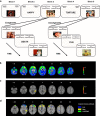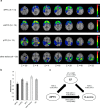Brain Regions Influencing Implicit Violent Attitudes: A Lesion-Mapping Study
- PMID: 26937013
- PMCID: PMC6604866
- DOI: 10.1523/JNEUROSCI.2975-15.2016
Brain Regions Influencing Implicit Violent Attitudes: A Lesion-Mapping Study
Abstract
Increased aggression is common after traumatic brain injuries and may persist after cognitive recovery. Maladaptive aggression and violence are associated with dysfunction in the prefrontal and temporal cortex, but such dysfunctional behaviors are typically measured by explicit scales and history. However, it is well known that answers on explicit scales on sensitive topics--such as aggressive thoughts and behaviors--may not reveal true tendencies. Here, we investigated the neural basis of implicit attitudes toward aggression in humans using a modified version of the Implicit Association Task (IAT) with a unique sample of 112 Vietnam War veterans who suffered penetrating brain injury and 33 healthy controls who also served in combat in Vietnam but had no history of brain injury. We hypothesized that dorsolateral prefrontal cortex (dlPFC) lesions, due to the crucial role of the dlPFC in response inhibition, could influence performance on the IAT. In addition, we investigated the causal contribution of specific brain areas to implicit attitudes toward violence. We found a more positive implicit attitude toward aggression among individuals with lesions to the dlPFC and inferior posterior temporal cortex (ipTC). Furthermore, executive functions were critically involved in regulating implicit attitudes toward violence and aggression. Our findings complement existing evidence on the neural basis of explicit aggression centered on the ventromedial prefrontal cortex. These findings highlight that dlPFC and ipTC play a causal role in modulating implicit attitudes about violence and are crucially involved in the pathogenesis of aggressive behavior.
Significance statement: Maladaptive aggression and violence can lead to interpersonal conflict and criminal behavior. Surprisingly little is known about implicit attitudes toward violence and aggression. Here, we used a range of techniques, including voxel-based lesion-symptom mapping, to examine the causal role of brain structures underpinning implicit attitudes toward aggression in a unique sample of combat veterans with traumatic brain injury. We found that damage to the dorsolateral prefrontal cortex (dlPFC) led to a more positive implicit attitude toward violence that under most normal situations would be considered inappropriate. These results suggest that treatments aimed at increasing cognitive control using cognitive behavioral therapies dependent on the intact dlPFC could treat aggressive and violent behavior.
Keywords: aggression; implicit attitudes; traumatic brain injury.
Copyright © 2016 the authors 0270-6474/16/362757-12$15.00/0.
Figures


Similar articles
-
Frontal lobe injuries, violence, and aggression: a report of the Vietnam Head Injury Study.Neurology. 1996 May;46(5):1231-8. doi: 10.1212/wnl.46.5.1231. Neurology. 1996. PMID: 8628458
-
Using reaction time procedures to assess implicit attitudes toward violence in a nonconvicted male sample.Aggress Behav. 2024 Jun;50(4):e22168. doi: 10.1002/ab.22168. Aggress Behav. 2024. PMID: 39073175
-
Aggression, DRD1 polymorphism, and lesion location in penetrating traumatic brain injury.CNS Spectr. 2014 Oct;19(5):382-90. doi: 10.1017/S1092852914000108. Epub 2014 Mar 11. CNS Spectr. 2014. PMID: 24618367 Free PMC article.
-
Transcranial magnetic stimulation of medial prefrontal cortex modulates implicit attitudes towards food.Appetite. 2015 Jun;89:70-6. doi: 10.1016/j.appet.2015.01.014. Epub 2015 Jan 22. Appetite. 2015. PMID: 25620531 Review.
-
A forensic neuropsychiatric approach to traumatic brain injury, aggression, and suicide.J Am Acad Psychiatry Law. 2013;41(2):274-86. J Am Acad Psychiatry Law. 2013. PMID: 23771941 Review.
Cited by
-
A systematic review of neural, cognitive, and clinical studies of anger and aggression.Curr Psychol. 2022 Jun 8:1-13. doi: 10.1007/s12144-022-03143-6. Online ahead of print. Curr Psychol. 2022. PMID: 35693838 Free PMC article.
-
Social Cognition Dysfunctions in Neurodegenerative Diseases: Neuroanatomical Correlates and Clinical Implications.Behav Neurol. 2018 Apr 26;2018:1849794. doi: 10.1155/2018/1849794. eCollection 2018. Behav Neurol. 2018. PMID: 29854017 Free PMC article. Review.
-
Traumatic Brain Injury and Related Antisocial Behavioral Outcomes: A Systematic Review.Medicina (Kaunas). 2023 Jul 27;59(8):1377. doi: 10.3390/medicina59081377. Medicina (Kaunas). 2023. PMID: 37629667 Free PMC article.
-
The Spectrum of Long-Term Behavioral Disturbances and Provided Care After Traumatic Brain Injury.Front Neurol. 2020 Apr 7;11:246. doi: 10.3389/fneur.2020.00246. eCollection 2020. Front Neurol. 2020. PMID: 32318019 Free PMC article.
-
Implicit Attitudes and Addictive Behaviors Among Methamphetamine Users: The Moderation of Depression.Psychol Res Behav Manag. 2025 Jul 7;18:1545-1552. doi: 10.2147/PRBM.S512321. eCollection 2025. Psychol Res Behav Manag. 2025. PMID: 40656761 Free PMC article.
References
Publication types
MeSH terms
LinkOut - more resources
Full Text Sources
Other Literature Sources
